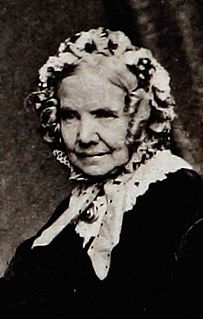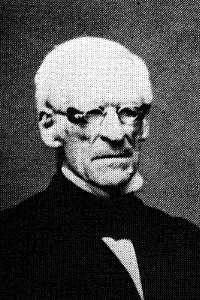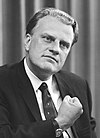The Finlandia hymn refers to a serene hymn-like section of the patriotic symphonic poem Finlandia, written in 1899 and 1900 by the Finnish composer Jean Sibelius. It was later re-worked by the composer into a stand-alone piece.

Love Divine, All Loves Excelling is a Christian hymn by Charles Wesley with a theme of "Christian perfection." Judging by general repute, it is among Wesley's finest: "justly famous and beloved, better known than almost any other hymn of Charles Wesley." Judging by its distribution, it is also among his most successful: by the end of the 19th century, it is found in 15 of the 17 hymn books consulted by the authors of Lyric Studies. On a larger scale, it is found almost universally in general collections of the past century, including not only Methodist and Anglican hymn books and commercial and ecumenical collections, but also hymnals published by Reformed, Presbyterian, Baptist, Brethren, Seventh-day Adventist, Lutheran, Congregationalist, Pentecostal, and Roman Catholic traditions, among others including the Churches of Christ. Specifically, it appears in 1,328 of the North American hymnals indexed by the online Dictionary of North American Hymnology, comparable to Newton's "Amazing Grace" (1,036), Wesley's "O for a Thousand Tongues" (1,249), and Watts' "When I Survey the Wondrous Cross" (1,483), though still well short of Toplady's "Rock of Ages" (2,139) or Wesley's own "Jesu, Lover of my Soul" (2,164).
"I Vow to Thee, My Country" is a patriotic hymn, created in 1921, when a poem by Sir Cecil Spring Rice was set to music by Gustav Holst.
"Old 100th" or "Old Hundredth" is a hymn tune in Long Metre from Pseaumes Octante Trois de David (1551) and is one of the best known melodies in all Christian musical traditions. The tune is usually attributed to the French composer Louis Bourgeois.

"Be Thou My Vision" is a traditional Christian hymn of Irish origin. The words are based on a Middle Irish poem often attributed to the sixth-century Irish Christian poet Dallán Forgaill, although it is probably later than that. The best-known English version, with some minor variations, was translated by Eleanor Hull and published in 1912. Since 1919 it has been commonly sung to an Irish folk tune, noted as “Slane” in church hymnals, and is one of the most popular hymns in the United Kingdom.

Frances Ridley Havergal was an English religious poet and hymnwriter. Take My Life and Let it Be and Thy Life for Me are two of her best known hymns. She also wrote hymn melodies, religious tracts, and works for children. She did not occupy, and did not claim for herself, a prominent place as a poet, but by her distinct individuality, she carved out a niche which she alone could fill.

"Rock of Ages" is a popular Christian hymn written by the Reverend Augustus Toplady in 1763 and first published in The Gospel Magazine in 1775.
Decisions concerning the conduct of public worship in the Church of Scotland are entirely at the discretion of the parish minister. As a result, a wide variety of musical resources are used. However, at various times in its history, the General Assembly has commissioned volumes of psalms and hymns for use by congregations.

"Come Thou Fount of Every Blessing" is a Christian hymn written by the 18th century pastor and hymnodist Robert Robinson. Robert Robinson penned the words at age 22 in the year 1757.
"For the Beauty of the Earth" is a Christian hymn by Folliott S. Pierpoint (1835-1917).
"Fairest Lord Jesus", also known as "Beautiful Savior", is a Christian hymn.

"How Great Thou Art" is a Christian hymn based on a Swedish traditional melody and a poem written by Carl Boberg (1859–1940) in Mönsterås, Sweden, in 1885. It was translated into German and then into Russian. It was translated into English from the Russian by English missionary Stuart K. Hine, who also added two original verses of his own. It was popularised by George Beverly Shea and Cliff Barrows during the Billy Graham crusades. It was voted the United Kingdom's favourite hymn by BBC's Songs of Praise. "How Great Thou Art" was ranked second on a list of the favourite hymns of all time in a survey by Christianity Today magazine in 2001.
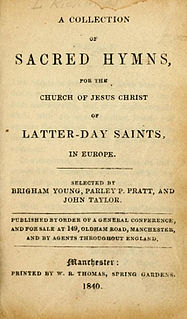
A Collection of Sacred Hymns for the Church of Jesus Christ of Latter-day Saints in Europe, informally known as the Manchester Hymnal, was first published in Manchester, England, in 1840. Like the first Latter Day Saint hymnal, this hymnal is text-only; it went through many editions, lasting until 1912 —future editions supposedly had extra hymns added, but the first few had 271.
"Gwahoddiad" is a Welsh hymn of American origin.
Ebenezer, also known as Ton-y-Botel is a famous Welsh hymn tune composed by Thomas John Williams A.T.S.C. and extracted from the second movement of his Anthem "Golau Yn Y Glyn". // The tune is named after Ebenezer Chapel in Rhos near Pontardawe, South Wales which he attended while composing the tune. // Ebenezer means "Stone of Help" in the Bible. // Born in Ynysmeudwy near Pontardawe and lived in Llanelli, South Wales from 1903. // He served as organist and choir director at Zion Baptist Chapel and Calfaria Baptist Chapel in Llanelli. // Buried in Llanelli District Cemetery. // He introduced Ebenezer to the Hymnal "Llawlyfr Moliant" in 1890. // The myth that the tune was discovered in a bottle on a Llyn Peninsula beach in North Wales was published in the Daily Mail in 1902. It has affectionately been known as Ton-y-Botel ever since and is even referred to as "Ebenezer, Ton-y-Botel" on his grave headstone. //
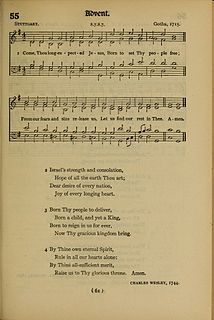
"Come, Thou Long Expected Jesus" is a 1744 Advent and Christmas carol common in Protestant hymnals. The text was written by Charles Wesley. It is performed to one of several tunes, including "Stuttgart" and "Hyfrydol". It is hymn number 66 in the Episcopal Church hymnal ; hymn number 196 in the United Methodist Hymnal ; hymns 1 and 2 in the 1990 Presbyterian Hymnal; and hymn 254 in Evangelical Lutheran Worship, among others. The hymn is considered an enduring classic in Christian hymnology.
Edward Wilton Eddis was a poet and prophet in the Catholic Apostolic Church at Westminster, London and co-author of the Hymns for the Use of the Churches, the hymnal of the Catholic Apostolic Church.

"O'er the Gloomy Hills of Darkness", also titled "O'er Those Gloomy Hills of Darkness", is a Welsh Christian hymn by William Williams Pantycelyn written in 1772. The hymn was written as a missionary hymn; there are conflicting accounts of why the hymn was written. The hymn was later published in 374 hymnals worldwide, though it was censored and altered in the United States by slaveholders for evangelising to slaves. The hymn later fell out of favour with hymn book editors in the 1960s.


